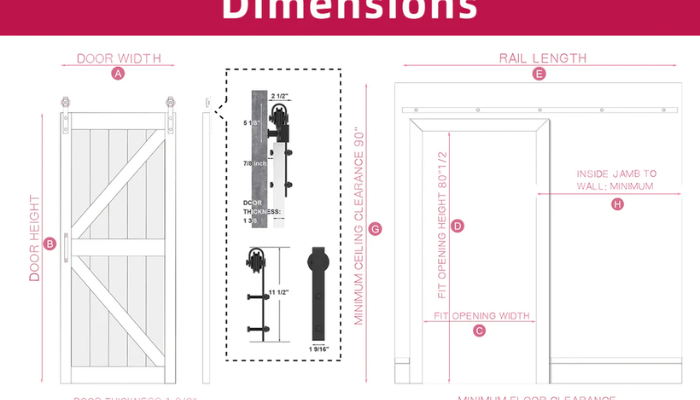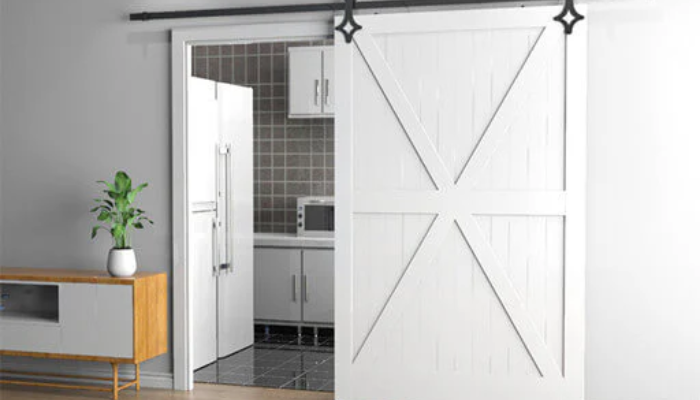
Barn doors have become a popular choice for homeowners looking to add a rustic yet modern touch to their interiors. Whether used for bedrooms, bathrooms, or even as decorative partitions, barn doors offer space-saving functionality and aesthetic appeal. However, choosing the right barn door dimensions is essential for seamless operation and a polished look. In this guide, we’ll break down everything you need to know about barn door sizes, measurements, and installation considerations.
Standard Barn Door Dimensions: What You Need to Know
Common Sizes for Barn Doors
Barn doors come in various standard sizes, making it easier to find a perfect fit for most openings. The most common barn door dimensions are:
- Width: 24″, 30″, 36″, 42″, and 48″ inches
- Height: 80″, 84″, and 96″ inches
- Thickness: Typically ranges from 1 3/8″ to 2 1/4″
These standard sizes ensure compatibility with most interior door frames. If your doorway falls within these dimensions, finding a pre-made barn door will be a convenient option.
Custom Barn Door Sizes
If your door opening is wider or taller than standard measurements, you may need a custom barn door. Custom dimensions allow for flexibility in unique spaces, ensuring that your door fits perfectly without gaps. When opting for a custom barn door, always measure the exact width and height of your doorway, adding a few extra inches to cover the frame entirely.
How to Measure for a Barn Door Correctly
Step-by-Step Measurement Guide
Before purchasing or building a barn door,barn door dimensions precise measurements are crucial. Follow these steps for accuracy:
- Measure the width: Take the measurement of your doorway and add at least 2–4 inches on each side for full coverage.
- Measure the height: Measure from the floor to the top of the doorway and add an extra inch or two to ensure smooth gliding.
- Account for hardware: Consider the track length, which should be at least double the door width for optimal function.
Avoiding Common Measurement Mistakes
One common mistake is underestimating the necessary overlap. A door that exactly matches the doorway width may leave gaps, reducing privacy. Always add extra inches for a seamless closure. Another mistake is failing to consider floor clearance, which is essential for smooth operation, especially on uneven surfaces.
Choosing the Right Barn Door Size for Your Space
Single vs. Double Barn Doors
The size of your opening determines whether you should use a single or double barn door barn door dimensions:
- Single barn doors work well for standard doorways up to 48 inches wide.
- Double barn doors are ideal for larger openings, ranging from 60 inches to 96 inches in width.
Choosing between single and double doors depends on your space availability and the look you wish to achieve. Double doors often create a more balanced and grand appearance.
Ideal Barn Door Dimensions for Different Rooms
- Bedroom & Closet Doors: 36″ x 84″ (standard size)
- Bathroom Doors: 30″ x 80″ (to ensure privacy)
- Pantry Doors: 24″ x 84″ (narrow yet functional)
- Living Room Partitions: Custom sizes based on the opening width
Hardware Considerations for Barn Doors

Track Length and Installation Space
A barn door track should be at least twice the width of the door for proper sliding motion. For example,barn door dimensions a 36-inch door needs a 72-inch track. Ensure there’s enough wall space for the door to slide fully open.
Door Thickness and Hardware Compatibility
Most barn door hardware supports doors 1 3/8″ to 2 1/4″ thick.barn door dimensions If using a thicker or custom door, ensure your hardware kit is compatible to prevent installation issues.
Installation Tips for the Perfect Barn Door Fit
Preparing the Wall and Mounting Surface
Before installation:
- Ensure your wall can support the weight of the barn door and track system.
- Use a header board if mounting on drywall to distribute weight evenly.
Ensuring Smooth Operation
To prevent wobbling or dragging:
- Install floor guides to keep the door aligned.
- Regularly check the rollers and track for dust buildup or obstructions.
Conclusion
Selecting the right barn door dimensions is essential for both function and aesthetics. From standard sizes to custom options, measuring your space correctly ensures a seamless fit. Whether choosing a single or double barn door, considering track length, clearance, and hardware compatibility will guarantee a smooth and stylish installation. Now that you have a comprehensive understanding of barn door dimensions, you can confidently choose the best fit for your home.
FAQs About Barn Door Dimensions
1. What is the ideal barn door width?
The ideal width is at least 2–4 inches wider than the doorway to ensure full coverage barn door dimensions.
2. Can I use a standard interior door as a barn door?
Yes, but you may need to reinforce it with a proper track system and handle modifications.
3. How do I determine the right track length for my barn door?
The track should be at least twice the width of the door for full movement.
4. What is the standard height of a barn door?
Most barn doors are 80, 84, or 96 inches tall.
5. Can barn doors be used in bathrooms?
Yes,barn door dimensions but ensure they overlap the doorway sufficiently for privacy.
6. How thick should a barn door be?
Standard thickness is between 1 3/8″ and 2 1/4″.
7. Do I need a floor guide for a barn door?
Yes, floor guides prevent wobbling and keep the door aligned.
8. How much space do I need for a barn door to slide?
You need at least the door’s width as clearance on one side of the opening.
9. Can barn doors be installed on drywall?
Yes, but a header board is recommended for additional support.
10. What is the best material for barn doors?
Wood, MDF, and metal are popular choices,barn door dimensions depending on style and durability needs.





